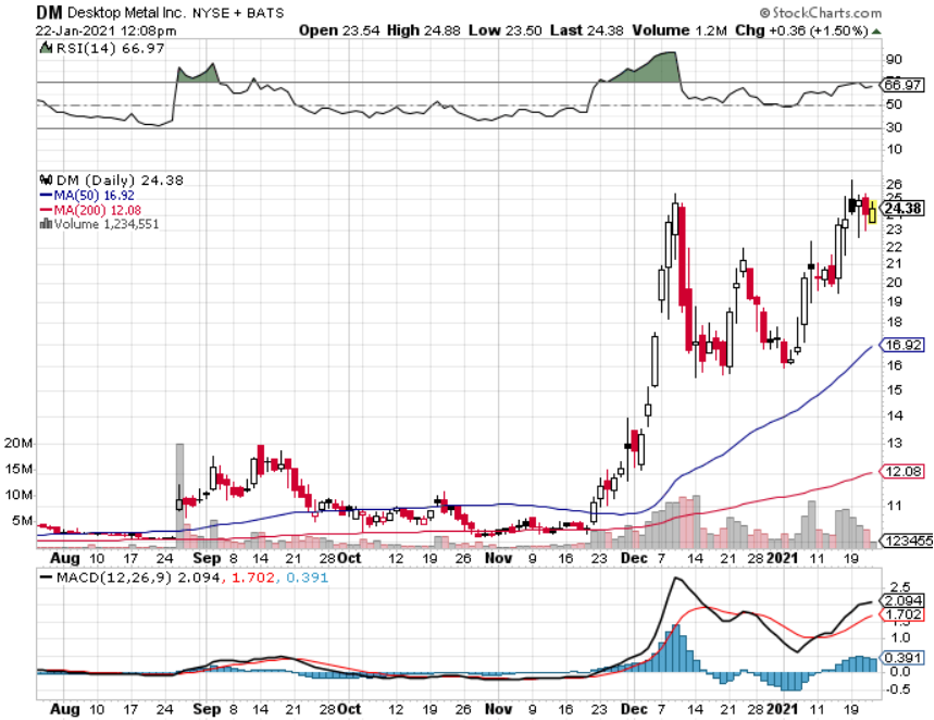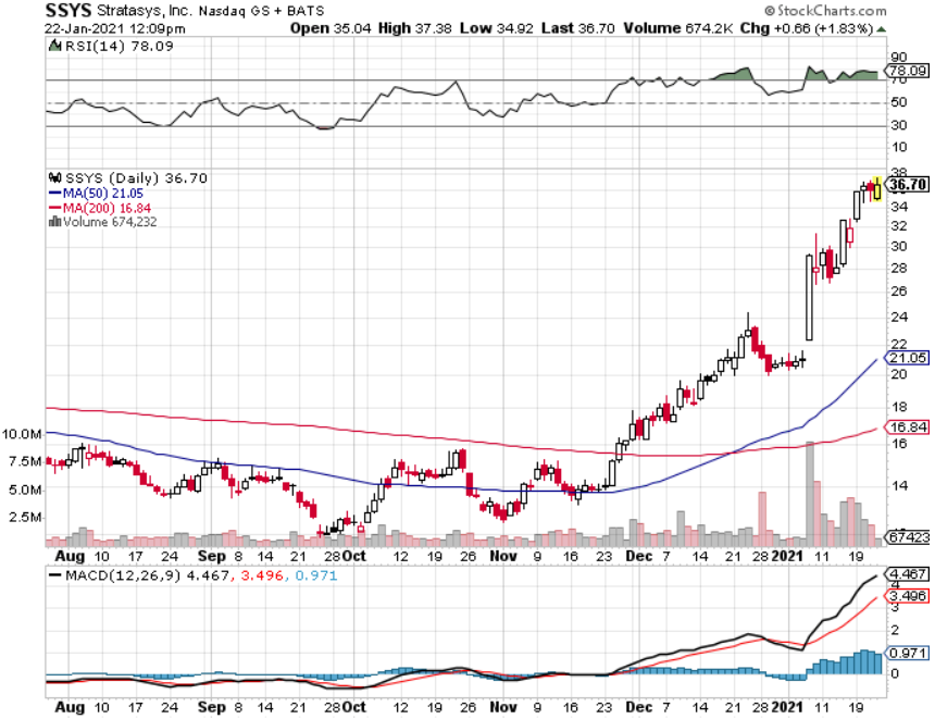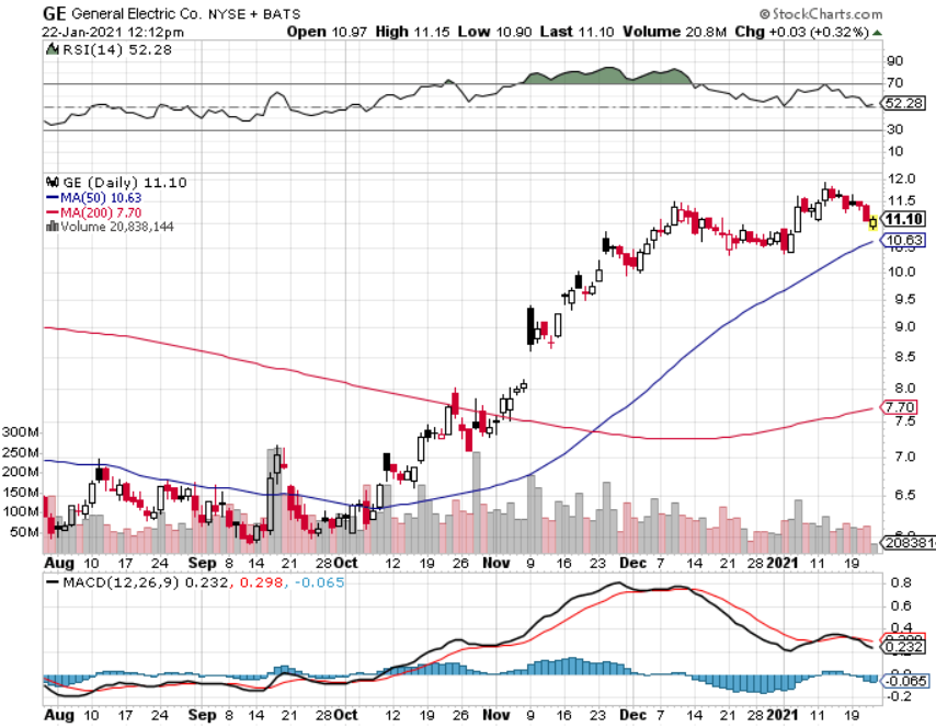When John identifies a strategic exit point, he will send you an alert with specific trade information as to what security to sell, when to sell it, and at what price. Most often, it will be to TAKE PROFITS, but, on rare occasions, it will be to exercise a STOP LOSS at a predetermined price to adhere to strict risk management discipline. Read more
When John identifies a strategic exit point, he will send you an alert with specific trade information as to what security to sell, when to sell it, and at what price. Most often, it will be to TAKE PROFITS, but, on rare occasions, it will be to exercise a STOP LOSS at a predetermined price to adhere to strict risk management discipline. Read more
Mad Hedge Technology Letter
January 25, 2021
Fiat Lux
Featured Trade:
(THE NEWEST PORTAL FOR FINANCIAL SCAMS)
(TIKTOK)
Sometimes the best way to become successful at investing in technology stocks is to avoid the black swan or the big disaster.
I hate to say it but investing risk has never been higher as we migrate our lives to the internet to extract what we need from personal to business affairs.
One question that keeps getting rehashed that I thought I might take time to address is the rise of TikTok influencer-adviser.
According to a brief Google search, TikTok, known in China as Douyin, is a video-sharing social networking service owned by Chinese company ByteDance. The social media platform is used to make a variety of short-form videos, from genres like dance, comedy, and education, that have a duration from three seconds to one minute.
Unfortunately, for serious retail investors lately, content has migrated into high-stakes themes like finance and financial advising giving rise to content that is produced by video creators to get a piece of the financial industry.
Naturally, this has brought down the level of the financial content on the internet to historic lows simply because most of the content is marginal at best.
These promulgators often preach about their status of “trading gurus” and often leverage the hype of digital currencies to claim they are fully invested in “crypto assets” and urge anyone reading to become one of their new “cult followers.”
They are also usually paid to market a bulletproof financial app or certain crypto asset to avid followers without properly disclosing that they are being paid for the advertisement.
This behavior is being encouraged by the TikTok algorithms who order this type of misleading content at the top of searches simply because it gets more hits being a click-bait type of content.
The more outlandish the videos become, gloating about get-rich-quick schemes and 1,000% daily returns, the higher up in the search queries they usually populate when filtered through TikTok algorithms.
These accounts are known as financial “influencers” and share 100s of such videos every month featuring fraudulent success or minimizing the difficulty of profiting through trading and a mix or mash of everything in between.
Even some proclaim to have unlocked the holy grail of trading and “guarantee” 100% returns or your money back.
Another speaking point they like to touch on is how video watchers can “also” afford wealthy lifestyles without having to work, at least in the traditional way.
The sad fact is that this content is incredibly hurtful for naïve or beginning investors.
To dumb down the travails of investing and trading to something easier than pouring a glass of water is a lie.
Many of these novice investors are duped into paying for services that are nothing more than promotional buzz offering hyped-up marketing language as specific trading advice.
Unfortunately, US regulators have turned a blind eye to what is happening on this Chinese platform, and imitators are spawned daily and are certainly incentivized to do so.
While I must admit that regulating this type of behavior on TikTok is incredibly messy, to leave this unchecked will result in massive fraud for the little guy that I try to help.
I will say the main reason for ignoring these TikTok “influencers” is because there is even worse cybercrime taking place out there and the content these influencers are peddling is straddling the gray areas of the law.
The digital migration during Covid has created a tsunami of fresh cybercrime that is really making the TikTok gurus look like choir boys.
Here are some statistics to stew over according to Gartner research.
- 88% of organizations worldwide experienced spear-phishing attempts in 2020.
- 68% of business leaders feel their cybersecurity risks are increasing.
- On average, only 5% of companies’ folders are properly protected.
- Data breaches exposed 36 billion records in the first half of 2020.
- 86% of breaches were financially motivated and 10% were motivated by espionage.
- 45% of breaches featured hacking, 17% involved malware and 22% involved phishing.
When digital professionals went remote, this also increased the risk of cybercriminals wreaking havoc by isolating their targets.
In the scheme of the internet, the TikTok trading “gurus” are small fish to fry when hackers are attempting to topple state of federal governments and Fortune 500 companies; but that doesn’t make it okay.
The Financial Conduct Authority (FCA) is already looking into trading scams and considering ramping up its capacity to monitor those TikTok creators and others who are flogging trading signals, managed investment services, or other fraudulent services.
But it’s not enough, and readers need to understand the heightened risks of diving feet first into these TikTok vortexes where you just get whipped around unknowingly.
Pre-emptively protect your portfolio by avoiding these TikTok trading gurus.
Stay vigilant and happy trading and just know there is no holy grail of trading.
It’s hard work earning your crust of bread.
THE NEWEST RABBIT HOLE FOR FINANCIAL SCAMS
“There are two kinds of companies, those that work to try to charge more and those that work to charge less. We will be the second.” – Said CEO and Founder of Amazon Jeff Bezos
Global Market Comments
January 25, 2021
Fiat LuxFeatured Trade:
(MARKET OUTLOOK FOR THE WEEK AHEAD, or HERE COMES THE SUPERHEATED ECONOMY),
(SPY), ($INDU), (TLT), (TBT), (TSLA)
The US economy is in the worst condition in a century. The U6 Unemployment rate stands at 20 million today. Main streets everywhere are boarded up. Millions of businesses have gone under. Some 4,500 people a day are dying from a dreaded virus.
All of this means that you should rush out and buy and stocks, as many as possible, with both hands, and by the bucket load. It’s time to take out that home equity loan and pour it into stocks, damn the torpedoes.
For things are about to get better for the US economy, a whole lot better, better beyond anyone’s wildest imagination, and for you individually.
Speaking to CEOs, fund managers, and hedge fund strategists, it is clear that most are wildly underestimating the strength of the 2021 recovery. People haven’t really added up all the stimulus and quantitative easing that is about the hit, which could reach $20 trillion. The total market value of US stock markets is only $51 trillion.
I hate to engage in some simplistic calculations here, but if you increase the amount of capital going into the economy by nearly 50% in two years, stocks just might go up by nearly 50% in two years. It’s no more complicated than that.
In fact, economic conditions are about to improve so fast that the Federal Reserve may have to break its promise about not raising interest rates for three years and instead start nudging them up by the end of 2021.
Needless to say, this is terrible news for the bond market (TLT), where I am lining up to go from a double to a triple short.
You are already starting to see other analysts ratchet up their overcautious yearend S&P 500 target. By November, they may reach my own outsized goal of 4,800, bringing in a total gain in stocks of 35%.
All of this explains why stocks just absolutely refuse to go down, even a little bit. Each one-day decline seems to be met with a wall of buying. The memo is out: you absolutely have to get into this market, whether you are an individual, hedge fund, institution, or outright bet the ranch gambler.
Of course, if you think I’m so bullish because I made 90% on my money since the April bottom, you’d be right.
Just keep your discipline and observe the basic rules of trading: 1) Don’t buy a position that is so big that it can’t handle a normal 10% correction, 2) Don’t accumulate a position that is so big that you can’t sleep at night, 3) No calling John Thomas in the middle of the night and asking “I have a 3X position in this and their trading down in Asia, what should I do?”
If you have to ask the question, your position is too big.
Biden’s economic plan boosts growth forecasts, according to Goldman Sachs. Prospects have jumped from 6.4% to 6.6%, the highest in a half-century, on the back of a massive Covid-19 package.
Treasury Secretary Janet Yellen says “GO BIG” or go home to the Senate Finance Committee. She was there to get confirmation and push for Biden’s $1.9 trillion stimulus package. Markets are underestimating the extent of the stimulus headed our way, which could reach $10 trillion in addition to another $10 trillion in quantitative easing. Buy dips.
Index Funds are getting trashed, substantially trailing the S&P 500, as single-story stocks dominate the market. It’s become a stock pickers market in the extreme, with no more obvious example that (TSLA), up 1,000% in 9 months. Small caps, IPOs, and cyclical are getting all the action, leaving the (SPX) in the dust.
Tesla delivered its first Chinese Model Y, which will add 250,000 units to sales in 2021. It’s all part of Elon’s quest to take over the global automobile market. He plans to boost sales from 500,000 last year to 20 million in a decade. If so, the stock today still looks cheap. But is the quality the same?
Tesla Q4 registrations soar by 63%, in California, its largest market. It’s due to the runaway success of the Model Y small SUV. The stock is taking a long-overdue rest with a sideways “time” correction. It’s still true that if you buy the stock, you get the car for free.
Weekly Jobless Claims are still sky-high at 900,000. It’s a decline on the week but still horrifically high. The stock market may be starting to notice, with stocks moving sideways for two weeks.
Existing Home Sales soared to a 15-year high, up an amazing 22% YOY in December to a seasonally adjusted 6.76 million units. In the meantime, inventories hit all-time lows at only 1.9 months as they can’t build them fast enough. Sales of $1 million-plus homes are up an incredible 94%. The hottest markets were in Austin, TX, Tampa, FL, and Phoenix, AZ. New York was the worst, followed by San Francisco. The market is on fire and could continue for another decade. Pending tax breaks from the new tax bill will give homeownership another big push.
US Housing Starts jump 5.8%, to 1.7 Million units. Single-family homes are up 12% YOY, driven by the pandemic. Notice the enormous supply/demand gap which assures that home prices will keep rising for years. Rising mortgage interest rates so far have had no effect.
US Manufacturing PMI hits 14-Year high, according to Markit, their index jumping from 57.1 to 59.1. The performance would have been better if it weren’t for rampant parts shortages nationwide. It’s another argument for the long-term bull case.
When we come out the other side of pandemic, we will be perfectly poised to launch into my new American Golden Age, or the next Roaring Twenties. With interest rates still at zero, oil cheap, there will be no reason not to. The Dow Average will rise by 400% to 120,000 or more in the coming decade. The American coming out the other side of the pandemic will be far more efficient and profitable than the old. Dow 120,000 here we come!
My Mad Hedge Global Trading Dispatch shot out of the gate with an immediate 7.25%so far in January. That is net of a 4% loss on a Tesla short which I added one day too soon. Given the great heights of the market, I have trimmed my book to just a long in Tesla and a Short in US Treasury bonds.
That brings my eleven-year total return to 430.30% double the S&P 500 over the same period. My 11-year average annualized return now stands at a nosebleed new high of 38.80%. My trailing one-year return exploded to 74.44%, the highest in the 13-year history of the Mad Hedge Fund Trader. We have earned 90% since the March low.
The coming week will be a big one for big tech earnings.
We also need to keep an eye on the number of US Coronavirus cases at 25 million and deaths at 420,000, which you can find here. We are now running at a staggering 4,500 deaths a day.
When the market starts to focus on this, we may have a problem.
On Monday, January 25 at 9:30 AM EST, we get the Chicago Fed National Activity Index for December. Phillips (PSX) and Kimberly Clark (KMB) report.
On Tuesday, January 26 at 10:00 AM, we learned the new S&P Case Shiller National Home Price Index. Microsoft (MSFT), Johnson & Johnson (JNJ), and American Express (AMEX) report.
On Wednesday, January 27 at 10:00 AM, US Durable Goods for December are published. Apple (AAPL), Facebook (FB) and Tesla (TSLA) report.
On Thursday, January 28 at 9:30 AM, the first look at US GDP for Q4 is announced. McDonald’s (MCD), American Airlines (AA), and Visa (V) report.
On Friday, January 29 at 9:30 AM, US Personal Income and Spending for December is published. Ely Lilly (LLY) and Caterpillar (CAT) report. At 2:00 PM, we learn the Baker-Hughes Rig Count.
As for me, I have never been big on the “meme” thing, but you have to love the one that has been circulating about Bernie Sanders. Suddenly, he showed up on every transit system in the country. Clearly, the country was dying for a laugh. I include several pictures below. Hopefully, I won’t end up like him someday.
Stay healthy.
John Thomas
CEO & Publisher
The Diary of a Mad Hedge Fund Trader
When John identifies a strategic exit point, he will send you an alert with specific trade information as to what security to sell, when to sell it, and at what price. Most often, it will be to TAKE PROFITS, but, on rare occasions, it will be to exercise a STOP LOSS at a predetermined price to adhere to strict risk management discipline. Read more
Mad Hedge Technology Letter
January 22, 2021
Fiat Lux
Featured Trade:
(THE ADDITIVE MANUFACTURING BOOM)
(DM), (DDD), (SSYS), (GE)
Desktop Metal (DM) produces metal and carbon fiber 3D printing accessible to all engineers, designers, and manufacturers.
I’ve dipped my toe in this industry before by recommending Stratasys Ltd. (SSYS) whose stock has tripled from October 2020.
Since its inception, the company has been a happy recipient of generous funding channels and attracted total funding of $438M, always a good start.
Desktop Metal is truly well-capitalized after its SPAC transaction and strategically positioned to reap the rewards from a "dramatic increase" in the use of 3D printing for end-use part production over the next decade.
The company's outsourcing of manufacturing processes should generate strong free cash flow which should turn positive by 2023.
Sales are expected to explode 286% this year alone, passing $71 million by the end of 2021 as this technology becomes more mainstream.
This is the only publicly traded, pure-play additive manufacturing 2.0 company, and DM has the fastest metal 3D printing technology in the market.
DM is 20 times cheaper than existing laser-based metal 3D printing technologies while allowing the use of a much wider range of alloys.
Not only are they expanding at a rapid clip, but they are also in the perfect market to grow with revenue runway of 11x to $146B this decade, propelled by a shift from prototyping to mass production.
Unlike many other tech startups, the first-mover advantage is buttressed by a diverse blue-chip customer base in the automotive industry.
The automotive industry is a key vertical for volume additive manufacturing and they have started shipping a new, intermediate version of its P-50 Production System, the new P-1 printer, to Ford Motor Company (F).
Buying growth has been a go-to strategy for frothy tech companies as deploying extra capital to take advantage of new efficiencies by owning new assets has been a winning strategy.
M&A is a solid route as a “value creation” strategy and the systems subsector would appear to present a viable strategic acquisition candidate going forward.
Desktop Metal recently bought competitor 3D printing firm EnvisionTEC.
Founded in Germany in 2002, EnvisionTEC specializes in photopolymer additive manufacturing, putting its technology in more direct competition with the likes of 3D printing darling Carbon than Desktop Metal’s own existing competencies.
It’s pouring $300 million to acquire EnvisionTEC through a combination of cash and stock.
There is a great chance for Desktop Metal to grow here.
EnvisionTEC has the underlying technology with the ability to print in more than 190 materials, and Desktop Metal has the resources to help scale that tech.
Today, EnvisionTEC has over 5,000 customers across a broad spectrum of industries, including medical devices, jewelry, automotive, aerospace, and biofabrication.
They are major players in the dental market, more than tripling the number of Envision One dental shipments from 2019 to 2020 and with over 1,000 dental customers now using its AM machines for end-use parts.
Key customers include Cartier, Celgene, Ford, Hasbro, Oral Arts, Stuller, and Smile Direct Club.
In addition to extensive customer adoption, EnvisionTEC has a broad library of over 190 materials, featuring photopolymer resins with material properties in-line with or exceeding those of thermoplastics and multiple FDA-listed and 510(K)-cleared resins for the manufacturing of medical devices.
The company augments its robust proprietary material development efforts with a selectively open business model, leveraging relationships with major chemical companies such as Henkel Loctite, DSM Somos, Detax, Keystone, and Arkema to sell third-party, industry-validated resins for use with its additive manufacturing platforms.
This is most likely the beginning of many purchases as they are flush with new capital from the IPO and other outside investors.
Investors need to know there are a few risks to take note of.
The rapid prototyping to mass production timetable appears quite ambitious, especially since DM has had significant issues with deploying its technology in the field.
Also, the attractive branding of “additive manufacturing 2.0” perhaps could turn into an overhyped industry.
Even though they have solid technology to become successful, there are industry veterans that won’t just lie down including 3D Systems Corporation (DDD), General Electric (GE), (GE Additives), and SSYS.
These recipients are also beneficiaries of all the hot money pouring into the sector the past year.
China could also bring down the 3D printing sector with a race to zero type of domino effect.
DM is a 3D printing company stock to put on their watchlist and buying growth isn’t always a guarantee to buy the “right” growth, but let’s see how they execute it.
Either case, the secular tailwinds can’t be ignored and if this technology goes viral, then watch out.
Legal Disclaimer
There is a very high degree of risk involved in trading. Past results are not indicative of future returns. MadHedgeFundTrader.com and all individuals affiliated with this site assume no responsibilities for your trading and investment results. The indicators, strategies, columns, articles and all other features are for educational purposes only and should not be construed as investment advice. Information for futures trading observations are obtained from sources believed to be reliable, but we do not warrant its completeness or accuracy, or warrant any results from the use of the information. Your use of the trading observations is entirely at your own risk and it is your sole responsibility to evaluate the accuracy, completeness and usefulness of the information. You must assess the risk of any trade with your broker and make your own independent decisions regarding any securities mentioned herein. Affiliates of MadHedgeFundTrader.com may have a position or effect transactions in the securities described herein (or options thereon) and/or otherwise employ trading strategies that may be consistent or inconsistent with the provided strategies.
























